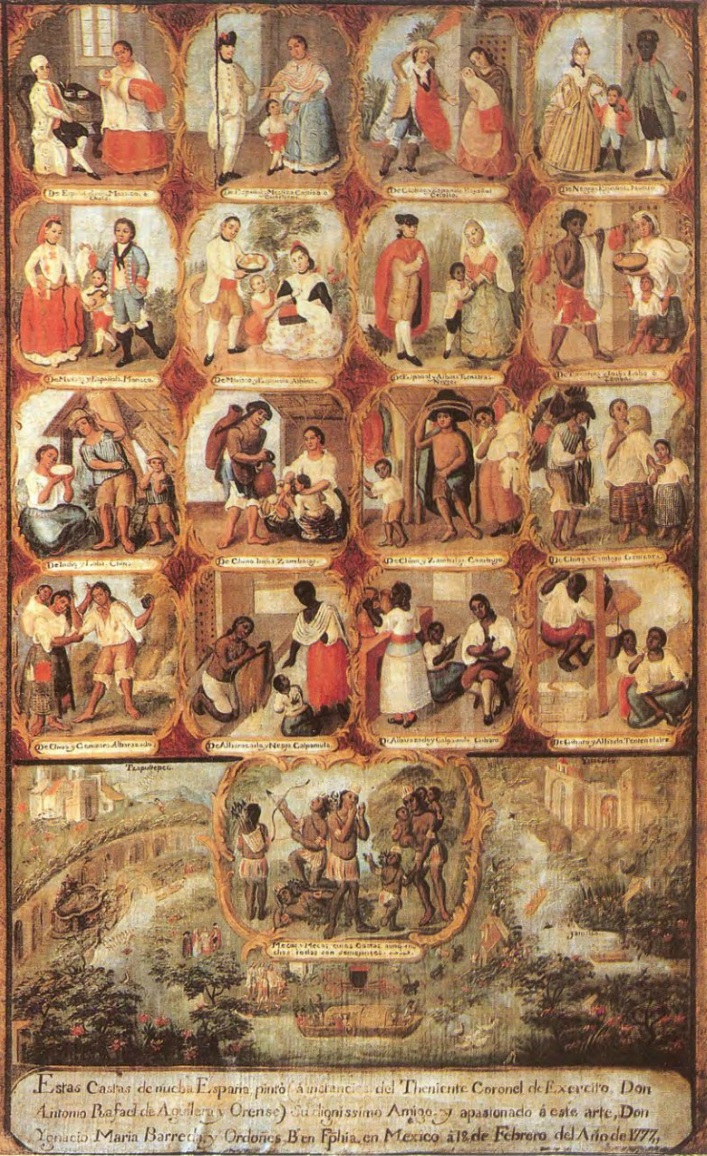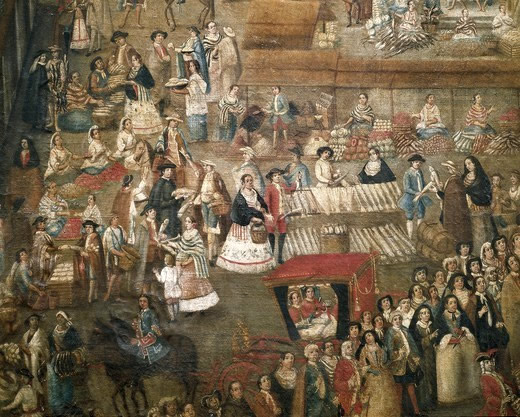In order to administer their vast holdings in the New World, the Spanish Crown devised an exceedingly intricate bureaucratic system intended to exert royal authority, to protects its economic and political interests, to maintain order and stability, and to prevent the formation of cohesive interest groups that might challenge royal authority. In theory, all political and legal authority in Spain’s overseas holdings ultimately derived from the Crown.
This system of what has been called “Hispanic absolutism” stood in sharp contrast to the situation in British North America, where various forms of local authority, including colonial and town assemblies, mingled with and effectively limited the exercise of royal authority.
Not so in Spain’s dominions, at least in theory, although in practice there quickly emerged substantial self-rule. Nor was there any legal or functional separation of executive, legislative, and judicial branches of government. While some bodies were more concerned with judicial matters, others with legislative and executive, effective distinctions among these functions did not exist.
  |
Nor was there a clear separation between royal and ecclesiastical authority, though in theory the Crown was the supreme authority in the colonies in consequence of the Patronato Real (Royal Patronage), which derived its legal basis from papal bulls of 1501 and 1508.
Habsburg Spain’s political culture was highly legalistic and placed a premium on the generation of paperwork, demonstrated by both the quality of the paper (still crisp after more than four centuries) and its quantity, most housed in the massive Archive of the Indies in Seville.
A key characteristic of the byzantine administrative hierarchy that governed Spain’s New World holdings was the functional overlapping of jurisdictions, as discussed later.
Some have proposed that the confusion and conflicts thus generated were part of an intentional strategy of “divide and rule” on the part of the Crown, a mechanism meant to ensure that subordinate administrative bodies would squabble among themselves, thus permitting the Crown to stand above the fray and act as the ultimate arbiter whenever serious conflicts arose. If this was not an intentional strategy—and opinion is divided on this point—it nonetheless worked in practice to that effect.
Hierarchical Structure
 |
| Depiction of casta in New Spain |
At the pinnacle of authority stood the king. Directly subordinate to him in the royal chain of command was the Council of the Indies (Consejo de Indias), established in 1524, modeled on the Council of Castile, and exercising supreme executive, legislative, and judicial authority in the day-to-day running of the American “kingdoms.”
The Council of the Indies, which comprised a dozen or so members, drafted and issued laws, interpreted laws, and nominated appointees to secular and religious offices, all subject to the king’s final approval. “Its tendency was meticulous and bureaucratic. It operated through lengthy, deliberative sessions surrounded by massive quantities of reports, laws, opinions, briefs, and other types of contemporary record.”
Within the colonies, the highest royal authority was the viceroy, conceived as the direct representative of the Crown in the colony. Viceroys were responsible for enforcing law, collecting revenues, administering justice, and maintaining order—virtually everything having to do with governing the viceroyalty. The viceroyalty was the largest administrative unit.
   |
Until 1717, all of Spain’s American holdings fell under the jurisdiction of two viceroyalties: the Viceroyalty of New Spain (created in 1535, capital Mexico City, embracing all of Southwest North America through Central America to Panama, with much of Central America under the jurisdiction of the Kingdom of Guatemala), and the Viceroyalty of Peru (or New Castile, created in 1542, capital at Lima, embracing all of South America not claimed by Portugal).
In 1717, a third viceroyalty, that of New Granada (Venezuela, Colombia, and Ecuador), was carved out of the Viceroyalty of Peru, and in 1776, a fourth, the Viceroyalty of La Plata (Argentina).
Partially subordinate to the viceroy were the audiencias, established before 1550 in Santo Domingo, Mexico City, Guatemala, New Galicia (in New Spain), and Panama, Lima, and Bogotá (in Peru), with more added later, and with much shifting of boundaries, jurisdictions, and status over the next 250 years. Judicially subordinate only to the Council of the Indies, the audiencias served as a kind of appellate court and legislative body, subject to royal approval.
Described as “the most durable and stable” of the many branches of colonial government, audiencias were composed of the colonies’ most prominent men: ecclesiastics, captains-general, encomenderos, merchants, landowners, and others, appointed by the council and king.
The boundaries between viceregal and audiencia authority were never clearly delineated, resulting in much disagreement between them. A similar situation obtained for local officials subordinate to the audiencias and viceroys, most notably alcaldes mayores, corregidores, and gobernadores, among whom leading authority Charles Gibson has discerned “no appreciable functional distinction.”
Each exercised administrative, judicial, and some legislative authority within its districts. Alcaldes were superior to regidores, while municipal councils (ayuntamientos and cabildos) were generally associated with corregidores.
Municipal councils were the only form of collective self-governance in the Spanish American colonies. There was nothing akin to colonial assemblies of British North America, for example. All authority was vested in individual officials and corporate bodies directly subordinate to royal authority.
The other major cor porate body charged with overseeing Spain’s New World colonies was the House of Trade (Casa de Contratación), founded in 1503 and located in Seville, which was to trade, commerce, and finance what the Council of the Indies was to politics, law, and governance.
The Crown, through its Seville-based mercantile guild (consulado), worked to maintain a royal monopoly on a wide variety of goods, from precious metals to tobacco to many other export commodities.
But despite the Crown’s efforts to maintain a relationship of mercantilism with the colonies, in everyday practice smuggling, contraband, and similar efforts to avoid royal monopolies and royal controls became very common.
Absolutist System
At no level of government did there exist any degree of democratic decision making. In theory, the system was absolutist: All authority flowed from the top down, and nothing but compliance from the bottom up.
In practice there existed a substantial degree of local self-governance by individual authorities, and considerable deviation from royal laws and decrees, most commonly expressed in the phrase obedezco pero no cumplo (“I obey but I do not fulfill”).
In other words, officials universally acknowledged the Crown’s supreme authority while very often balking at the enforcement of specific laws, usually premised on the belief that it was necessary to respond sensibly and pragmatically to realities on the ground.
Selective enforcement of the New Laws of 1542, intended to place limits on the institution of encomienda, ranks among the most prominent examples of this strong tendency to disobey or only selectively enforce royal laws and decrees.
Scholars continue to debate the consequences of this structure and style of colonial governance for postcolonial Spanish America. Key questions include the longterm implications of the institutionalization of endemic conflict among various branches of government, with the many claimants to political authority vying for supremacy, as expressed in the abundant lawsuits, appeals, and related forms of litigation that marked the entire colonial period.
Another concerns the cultural legacy bequeathed by the structural tendency toward disobedience to royal authority and the formation of a political culture in which practical deviation from the letter of the law became the norm.
Another key area of investigation focuses on the ways in which subordinate individuals and collectivities, particularly Indian communities, learned to use this elaborate legal structure to defend and advance their interests, as they did throughout the colonial period.
Some scholars argue that the Spanish American tradition of vesting local authority in individual officials, combined with the absence of substantial collective authority and democratic institutions, over time generated a political culture that emphasized executive authority far more than legislative or judicial authority, provoking sharp conflicts and diverse syntheses with republican and representative forms of governance and Enlightenment notions of citizenship in the postcolonial period, with many variations in time and space.

